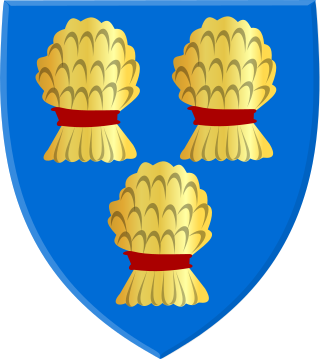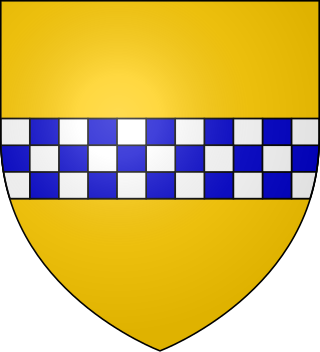Related Research Articles

Robert I, popularly known as Robert the Bruce, was King of Scots from 1306 to his death in 1329. Robert led Scotland during the First War of Scottish Independence against England. He fought successfully during his reign to restore Scotland to an independent kingdom and is regarded in Scotland as a national hero.

Year 1306 (MCCCVI) was a common year starting on Saturday of the Julian calendar.

The Battle of Methven took place at Methven, Scotland on 19 June 1306, during the Wars of Scottish Independence. The battlefield was researched to be included in the Inventory of Historic Battlefields in Scotland and protected by Historic Scotland under the Scottish Historical Environment Policy of 2009, but was excluded due to the uncertainty of its location.

Isabella of Mar was the first wife of Robert Bruce VII, Earl of Carrick. Isabella died before her husband was crowned King of Scotland. She and her husband were the grandparents of Robert II, King of Scotland, founder of the Royal House of Stuart.
Andrew Moray, also known as Andrew de Moray, Andrew of Moray, or Andrew Murray, was a Scottish esquire. He first rose to prominence during the First Scottish War of Independence, initially raising a small band of supporters at Avoch Castle in early summer 1297 to fight King Edward I of England. He soon had successfully regained control of the north for the absent Scots king, John Balliol. Moray subsequently merged his army with that of William Wallace, and jointly led the combined army to victory at the Battle of Stirling Bridge on 11 September 1297. He was severely wounded in that battle, dying at an unknown date and place that year.

John Comyn III of Badenoch, nicknamed the Red, was a leading Scottish baron and magnate who played an important role in the First War of Scottish Independence. He served as Guardian of Scotland after the forced abdication of his uncle, King John Balliol, in 1296, and for a time commanded the defence of Scotland against English attacks. Comyn was stabbed to death by Robert the Bruce before the altar at the church of the Greyfriars at Dumfries.

John Comyn II of Badenoch, Lord of Badenoch, nicknamed the Black Comyn, was a Scottish nobleman, a Guardian of Scotland, and one of the six Regents for Margaret, Maid of Norway. His father was John Comyn I of Badenoch.

James Stewart was the 5th Hereditary High Steward of Scotland and a Guardian of Scotland during the First Interregnum (1286–1292).

Sir Roger de Kirkpatrick of Closeburn was a Scottish gentleman, a 3rd cousin and associate of Robert the Bruce, a 1st cousin of Sir William Wallace. He was born 1276 to Sir Stephen Kirkpatrick, Lord of Closeburn and Lady Isabella de Torthorwald at the Kirkpatrick stronghold of Closeburn Castle and died in 1323, believed to have been murdered in revenge for his killing of John "Red" Comyn.

Sir Simon Fraser of Oliver and Neidpath was a Scottish knight who fought in the Wars of Scottish Independence, for which he was hanged, drawn, and quartered in 1306.
The Battle of Inverurie, also known as the Battle of Barra, was fought in the north-east of Scotland and was a victory for the Scottish king Robert Bruce over his chief domestic enemy, John Comyn, 3rd Earl of Buchan. Though part of the wider Wars of Scottish Independence, it is more properly viewed as an episode in a brief but bitter civil war. It was followed by the Harrying of Buchan, a violent act of destruction of property long remembered with bitterness in Buchan. The battle was fought in May 1308 according to Fordun. However, Barbour states clearly that it was fought at Christmas of 1307. Many current historians accept Fordun's date, but Barron and some others believe that Bower misinterpreted Fordun's notes. The battlefield was added to the Inventory of Historic Battlefields in Scotland in 2011.

John Comyn, 3rd Earl of Buchan was a chief opponent of Robert the Bruce in the civil war that paralleled the War of Scottish Independence. He should not be confused with the better known John III Comyn, Lord of Badenoch, who was his cousin, and who was killed by Bruce in Dumfries in March 1306. Confusion between the two men has affected the study of this period of history.
John Comyn (Cumyn) was Lord of Badenoch in Scotland. He was Justiciar of Galloway in 1258. He held lands in Nithsdale and Tynedale.

Clan Cumming, historically known as Clan Comyn, is a Scottish clan from the central Highlands that played a major role in the history of 13th-century Scotland and in the Wars of Scottish Independence. The Clan Comyn was once the most powerful family in 13th-century Scotland, until they were defeated in civil war by their rival to the Scottish throne, Robert the Bruce.
Dungal MacDouall was a fourteenth-century Scottish nobleman, and a member of the MacDouall family. He was a vigorous opponent of Robert I, King of Scotland during the First War of Scottish Independence, and was knighted by Edward I, King of England for his services to the English Crown. Dungal was a close associate of John MacDougall, Lord of Argyll, whom he may have regarded as a kinsman. Dungal received grants of lands in England and Ireland after losing his own in Scotland. During his career, Dungal commanded Dumfries Castle and Rushen Castle, and is described by a contemporary record as "Captain of the army of Galloway". Dungal had a large family, and was succeeded by his son, Duncan.
Sir Christopher Seton (1278–1306), also known as Christopher de Seton, was a 13th-century noble, who held lands in England and Scotland. He was a supporter of Robert the Bruce and obtained Robert's sister's hand in marriage. Present during the killing of John Comyn, Lord of Badenoch at Greyfriars Church, Dumfries, he also killed Sir Robert Comyn, who had rushed to Badenoch's aid. Seton was captured at Loch Doon Castle and executed at Dumfries in 1306.
Events from the year 1306 in the Kingdom of Scotland.
John Comyn IV, Lord of Badenoch was the son of John III "The Red" Comyn, former leader of Scottish rebels against the English, who was killed by Robert the Bruce in the Greyfriars church in Dumfries on 10 February 1306. He was sent to England after his father's death by his mother Jeanne de Valence.
Sir John de Seton was a knight who took part in the First War of Scottish Independence as a supporter of Robert de Brus. He held lands in England and Scotland.
Events from the 1290s in Scotland.
References
- Barrow, G.W.S. (2005) [1965]. Robert Bruce and the Community of the Realm of Scotland (4th ed.). Edinburgh University Press. ISBN 978-0-7486-2022-7.
- Murison, A. F. (2005) [1899]. King Robert the Bruce (reprint 2005 ed.). Kessinger Publishing. ISBN 9781417914944.